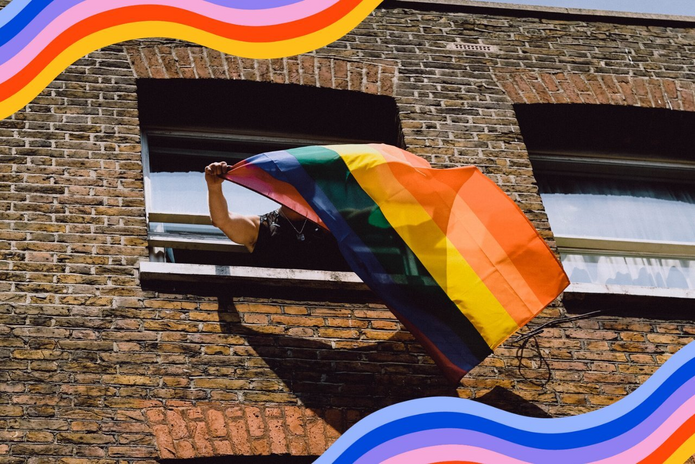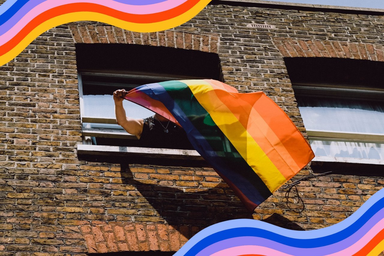Basically all IRL Pride events this year have been canceled or postponed. That doesn’t mean, however, that Pride month will pass us by unrecognized. In addition to smaller online Pride events throughout the month, InterPride and the European Pride Organizers Association have planned Global Pride 2020, a live-streamed, 24-hour festival that celebrates the diversity of LGBTQ people around the world.
With the only requirement to join being an internet connection, this year’s Pride events will be accessible to everyone regardless of disability, location, or socioeconomic status.
LGBTQ individuals with intersectional identities
For decades, Pride has remained inaccessible for the disabled, deaf or hard-of-hearing, blind, neurodiverse, and those with intellectual or developmental disabilities. Pride routes have been inaccessible for wheelchair users, and after-parties are often hosted in places without elevators or ramps. Numerous videos and presentations are shown without subtitles or interpreters. There is a common use of strobe lights and loud music at parties. So…it’s clear that Pride organizers do not always provide the radical inclusivity Pride is supposed to stand for.
I’m so v tired of “radical” spaces being inaccessible. It’s always on my mind: what events can I go to? Which ones aren’t for me? For which ones am I willing to deal with the repercussions later?
It always goes into overdrive just before Pride.
— Dean (@dean_strauss) May 22, 2019
By moving Pride online, organizers have created a new level of accessibility for LGBTQ individuals with intersectional identities. Beyond the obvious advantages, such as the elimination of physical barriers, a virtual Pride can ease sensory processing with neurodiverse members of the community, among other benefits. That being said, there will likely still be some impediments to a fully accessible Pride.
According to a 2017 Pew Research report, only 67% of disabled Americans ages 18 to 64 say they own a desktop or laptop computer, compared with 84% of those in the same group who don’t have a disability. And even if access to a device is not an issue, there are still many websites that do not accomodate disabled people. Websites are often presented as purely virtual interfaces, which don’t allow blind or low-vision people to use.
LGBTQ individuals in areas where being out is illegal or culturally unacceptable
For many of us, our only experience of Pride has been the giant celebrations held in liberal cities, making it easy to forget that over 70 countries currently criminalize consensual, same-sex sexual activity—over 10 of which include the death penalty as a legal possibility. And even countries which you may consider inclusive often have laws or statutes that discriminate based on sexual orientation or gender expression. This includes the U.S., where in 27 states there are no explicit statewide laws that protect people from discrimination on the basis of sexual orientation or gender identity in employment, housing, and public accommodations. For members of the LGBTQ community living in more conservative areas, attending a physical Pride may never have been an option.
The creation of an online Pride event, which allows viewers to participate from the safety of their own living spaces, could open up Pride to a whole new audience. In addition, all of the information and support that Pride supplies will now be accessible to these new viewers. Once again, however, a virtual Pride is not a panacea. Many countries monitor online activity or even have firewalls restricting access to certain sites. In places like these, it may be just as dangerous to attend Pride online as it would be in-person.
Engaging with allies
Allies are crucial to the progress of LGBTQ rights, and a virtual Pride is likely to bring in more straight people who might not have engaged with Pride otherwise. A virtual Pride also may provide a bigger platform for online adovacy that could sway more people to support equal rights.
One great example showing the importance of online advocacy and the support of allies is the story of how Ireland became the first country to win marriage equality by popular vote. By using online crowdfunding initiatives, social media campaigns, and generational cross-engagement, the Yes campaign was able to get over 60% of the country (the majority of whom were straight) to support marriage equality.
With Pride moving online, it will be easier for straight people to drop in and explore Pride, without facing the high bar it takes to attend a physical event. This could be an ideal way for family members or those who may be questioning cultural prejudices to gain some insight into the LGBTQ community.
Other factors
Finally, there are numerous smaller reasons why people may not attend a physical Pride event, from the cost of traveling to the location to the amount to time needed to participate. From the very minimal costs associated with online events to the freedom to join-in and watch as long as you wish, virtual Pride makes it easier for all people, regardless of socio-economic factors, to attend.
Looking forward to 2021
This year’s Pride events are likely to become the most-attended in history, and we shouldn’t forget what allowed them to be so accessible when we start planning in-person events in the coming years. Inaccessibility leaves out many members of the LGBTQ community and disregards the ultimate message of Pride—inclusion. Pride organizers should provide interpreters, organize routes and seating for the disabled, and concentrate on allowing all people to participate. And above all, we should learn that live-streams can make a huge difference, and that it’s not hard to put Pride events online.


